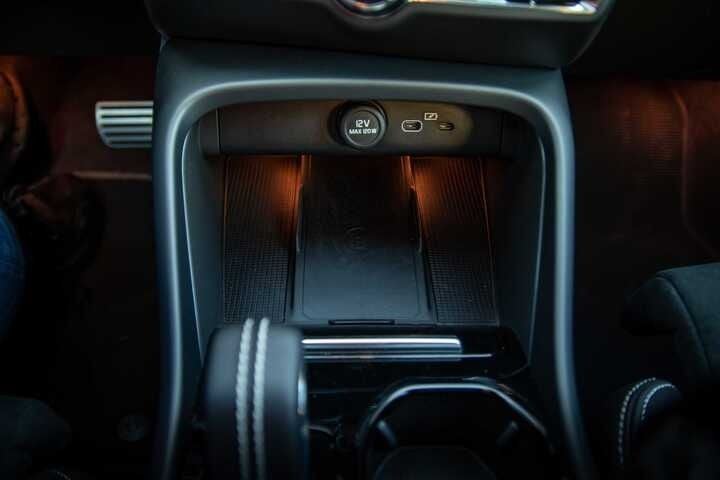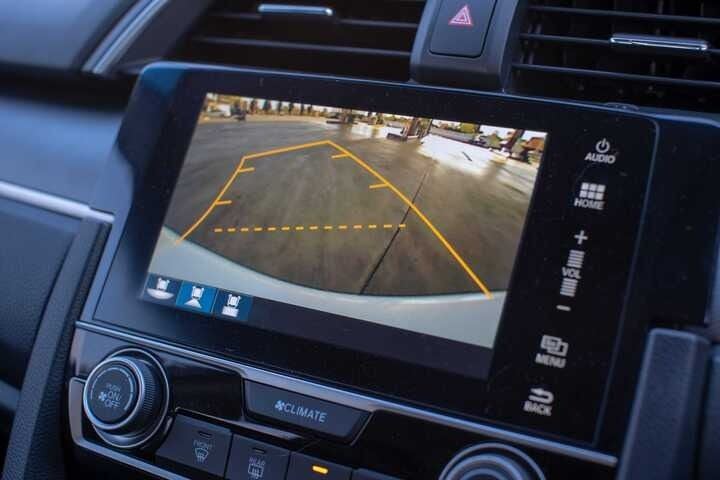The world is constantly evolving, and keeping up with all the technological advancements can be quite a task. Fortunately, we've got you covered with this comprehensive list of 12 new technologies in the automobile industry that are changing the way the world drives!
From self-driving cars to augmented reality dashboards, the latest car technologies are nothing short of groundbreaking. These innovations are not only making our lives easier but are also making driving safer and more enjoyable. While some of the new car technology might seem like science fiction, it's worth noting that many of these advancements are already on the market and making a real difference in our lives.
So join us as we explore the ins and outs of each innovation and see how they're transforming the way we drive.
List of New Car Technologies in India
1. Advanced Driver Assistance Systems

Advanced Driver Assistance Systems (ADAS) is an automobile technology that assists drivers in operating their vehicles. These systems use sensors, cameras and complex algorithms to provide drivers with real-time information about their surroundings and warn them of potential hazards. ADAS is designed to help drivers avoid accidents by providing them with early warnings and assistance in emergencies. These systems can also be used to provide drivers with information about the vehicle's speed, location, and other key parameters. ADAS includes features such as adaptive cruise control, blind spot detection, and automated parking.
Here are five things you need to know about ADAS:
- ADAS includes features such as lane departure warnings and adaptive cruise control, which are designed to make driving safer and more efficient.
- These systems are constantly evolving, with new features and technologies being added all the time. For example, some of the latest ADAS technologies include traffic jam assist, which helps drivers navigate congested traffic, and emergency stop assist, which can bring the vehicle to a halt if the driver becomes incapacitated.
- ADAS is not just for high-end luxury vehicles; many mainstream cars now come with some level of ADAS as a standard. This means that these technologies are becoming more accessible to a wider range of drivers.
- While ADAS can be incredibly useful, it's important to remember that they are not a replacement for a skilled and attentive driver. Drivers still need to pay attention to the road and be aware of their surroundings at all times.
- With ADAS becoming more widespread, we can expect to see a reduction in accidents and fatalities on the road, making driving safer for everyone.
Read More : Advanced Driver Assistance Systems: The Ultimate Guide to Types and Functionality
2. Automatic Emergency Braking

Automatic Emergency Braking (AEB) is a safety system that detects potential collisions and automatically applies the brakes to prevent or reduce the severity of an impact. This automobile technology is a derivative of the ADAS and uses a combination of sensors and cameras to monitor the road ahead. It can detect objects such as other vehicles, pedestrians or cyclists. AEB can also be used in combination with other safety features such as forward collision warning and lane departure warning to provide drivers with a comprehensive safety system. With AEB, drivers can have greater confidence in their vehicle's safety features and can be rest assured that the system will take action to protect them in case of an emergency.
Here are five things you need to know about AEB:
- AEB uses sensors and cameras to detect potential collisions and can apply the brakes to prevent or reduce the severity of an impact.
- AEB is becoming more common in modern cars, with many manufacturers like Toyota, Nissan, and Honda making it a standard feature on their vehicles.
- AEB is particularly useful in urban driving, where there are often unexpected hazards such as pedestrians or cyclists.
- While AEB can be incredibly helpful, it's important to remember that it is not foolproof yet.
- AEB is just one of many safety features that are becoming standard on modern cars, making driving safer for everyone.
Read More : How to Drive a Car – Manual & Automatic
3. Connected Mobile Apps/Digital Key

Connected mobile apps and digital keys are changing the way we interact with our vehicles. These apps allow drivers to remotely control and monitor their vehicles using their smartphones. With these apps, drivers can lock and unlock their cars, start the engine, adjust the climate control settings, and even locate their vehicles using GPS. Digital keys, on the other hand, eliminate the need for physical keys. Instead, the digital key is stored on the driver's smartphone, allowing them to access and start their vehicle without the need for a physical key. This new car technology is particularly useful for car-sharing services and rental companies, as it allows them to provide customers with easy access to their vehicles without the need for a physical key.
Here are five benefits of this technology:
- Drivers can use their smartphones to remotely lock or unlock their cars, making it easier to manage access to their vehicles.
- Connected mobile apps can also be used to start the car engine, control climate settings, and track the vehicle's location in real time.
- Digital keys are an excellent solution for drivers who frequently lose or misplace their physical keys, allowing them to access their cars using only their smartphones.
- This technology can also be used to share access to the vehicle with family members or friends, making it easier to coordinate trips and car-sharing arrangements.
- By utilising connected mobile apps, drivers can easily monitor their car's fuel levels, tyre pressure, and maintenance schedules, ensuring that the vehicle remains in optimal condition.
Read More : How To Unlock Car Door When Keys Locked in Car?
4. Wireless Smartphone Connectivity and Charging

Wireless smartphone connectivity is another innovative automobile technology that is becoming increasingly popular in modern vehicles. With wireless charging, drivers no longer need to worry about tangled cords or finding the right cable to charge their devices. Instead, they can simply place their smartphone on a wireless charging pad in the car and the device will charge automatically. This technology also allows drivers to easily connect their devices to the car's infotainment system, enabling them to access their music, contacts and navigation apps without the need for cables or adapters. This technology provides drivers with a seamless and convenient way to stay connected while on the road.
Here are five benefits of this technology:
- Drivers can easily connect their smartphones to the car's infotainment system, enabling them to make hands-free calls, play music, and use navigation apps without having to touch their devices.
- Wireless smartphone charging eliminates the need for cables and can be more convenient than traditional charging methods, allowing drivers to charge their devices on the go.
- This technology can also reduce the risk of distracted driving by minimising the need for drivers to interact with their devices while on the road.
- By utilising wireless smartphone connectivity and charging, drivers can reduce clutter in their cars, making it easier to stay organised and keep their vehicles clean.
- This technology can be particularly useful for long drives, enabling drivers to keep their devices charged and connected for extended periods.
5. 360-Degree Cameras

360 Degree cameras are revolutionising the way drivers view their surroundings. These cameras use multiple lenses to provide drivers with a complete view of their vehicle's surroundings, including areas that are typically difficult to see. This new car technology can help prevent accidents by providing drivers with a more comprehensive view of their environment. 360-degree cameras are particularly useful when parking, as they provide drivers with a bird's eye view of their vehicle, making it easier to navigate in tight spaces.
Some of the benefits of 360-degree cameras include:
- These cameras provide drivers with a complete view of their surroundings, making it easier to see potential hazards and obstacles.
- These cameras can help prevent accidents and improve overall safety.
- Parking can be a challenge, particularly in tight spaces. 360-degree cameras make it easier to park by providing drivers with a comprehensive view of their surroundings.
- 360-degree cameras can enhance the driving experience by providing drivers with a more immersive and intuitive view of their surroundings.
- Vehicles equipped with 360-degree cameras are typically more valuable than those without, making them a wise investment for car buyers.
6. Blind-Spot View Monitors

Blind-Spot view monitors use cameras and sensors to monitor the vehicle's blind spots and provide drivers with a warning if there is a vehicle in their blind spot. These monitors are particularly useful when changing lanes or merging onto the highway, as they help drivers avoid collisions by providing them with early warning of potential hazards.
Some of the benefits of blind-spot view monitors include:
- It can help prevent accidents by providing drivers with a clear view of their surroundings, which includes any vehicles in their blind spot.
- It helps improve visibility, making it easier to navigate through traffic and avoid hazards.
- With this technology, drivers no longer have to strain their necks or rely on mirrors to see vehicles in their blind spots.
- These monitors are easy to use and require no additional training or skills. Drivers can simply glance at the monitor to see other vehicles or obstructions in their blind spot.
- These monitors can be used in a wide range of vehicles, including cars, trucks and SUVs. This makes it a versatile technology that can be adapted to meet the needs of different drivers and vehicles.
7. Autonomous Vehicles

Autonomous Vehicles (AVs) are vehicles that are capable of driving themselves without human intervention. These vehicles use advanced sensors, software, and algorithms to navigate through traffic, detect obstacles, and make decisions about how to proceed. AVs have the potential to revolutionise the way we drive, making our roads safer, reducing congestion and improving mobility for people who cannot drive themselves.
Here are some of the benefits of Autonomous Vehicles:
- AVs have the potential to reduce the number of accidents on our roads. With advanced sensors and software, AVs can detect and avoid potential hazards, making driving safer for everyone.
- AVs can provide mobility to people who cannot drive themselves, such as the elderly, disabled or visually impaired. This technology can provide a level of independence and freedom that was previously unavailable to these groups.
- AVs can reduce traffic congestion by optimising traffic flow and reducing the number of vehicles on the road. This can help reduce travel times and improve the efficiency of our transportation systems.
- AVs can be powered by electric or hybrid engines, reducing the number of emissions produced by our transportation systems. This can help reduce air pollution and improve the environment.
- AVs can allow people to work, rest or engage in leisure activities during their commutes. This can help improve productivity and enhance the quality of life for people who spend a lot of time on the road.
8. Artificial Intelligence

Artificial Intelligence can be used to improve vehicle performance, enhance safety, and provide a more personalised driving experience. AI for cars involves the use of advanced algorithms and machine learning to analyse data from various sensors and sources and make decisions about how to operate the vehicle.
Here are some of the benefits of Artificial Intelligence for automobiles:
- AI can improve safety by predicting potential hazards and avoiding collisions. For example, AI can be used to detect pedestrians, cyclists and other vehicles and make decisions about how to proceed to avoid accidents.
- AI can be used to optimise vehicle performance, improving fuel efficiency, handling and acceleration. This can help provide a smoother and more enjoyable driving experience.
- AI can be used to personalise the driving experience, adjusting settings such as climate control, music and lighting to the driver's preferences.
- AI can be used to provide advanced navigation capabilities, taking into account traffic patterns, road conditions and weather.
- AI can be used to predict when vehicle components are likely to fail, allowing for preventative maintenance to be carried out before a breakdown occurs. This can help reduce maintenance costs and prevent unexpected breakdowns.
Read More : How ChatGPT Could Change the Automobile Industry
9. Remote Shutdown for Cars

This is a technology that allows car manufacturers and law enforcement agencies to remotely disable a vehicle in the event of theft or other criminal activity. This technology can be useful for preventing car theft and ensuring quick recovery of stolen vehicles. Remote shutdown for cars is achieved through the use of GPS tracking and wireless communication technology.
Here are some of the benefits of Remote Shutdown:
- Remote shutdown for cars can help prevent car theft and increase the chances of stolen vehicles being recovered quickly.
- Some insurance companies offer discounts for vehicles equipped with remote shutdown technology, as it reduces the risk of theft.
- Car manufacturers can reduce their liability for criminal activity involving their vehicles by equipping them with remote shutdown technology.
- Owners of vehicles equipped with remote shutdown technology can enjoy peace of mind knowing that their vehicle is protected from theft.
10. Active Health Monitoring
This is a technology that uses sensors and software to monitor the health of the driver and passengers in a vehicle. This technology can detect a range of health conditions, such as heart rate, blood pressure, oxygen levels and more. Active health monitoring can help ensure that drivers are fit to operate a vehicle and can alert them to potential health problems before they become serious.
Here are some of the benefits of Active Health Monitoring:
- It can help ensure that drivers are fit to operate a vehicle, reducing the risk of accidents caused by medical emergencies.
- It can detect potential health problems before they become serious, allowing drivers to seek medical attention before their condition worsens.
- It can provide drivers with personalised health management plans based on their health data, helping them to make informed decisions about their health.
- Early detection and management of health problems can help to reduce healthcare costs associated with serious illnesses or injuries.
- Active health monitoring can provide drivers with a more comfortable and stress-free driving experience by alerting them to potential health problems and providing them with peace of mind.
11. Electric Vehicles

EVs are becoming increasingly popular due to their environmentally friendly nature and improved technology. They are powered by electric motors and use rechargeable batteries, making them more efficient and cost-effective than traditional gas-powered cars. Electric vehicles have several advantages over their gas-powered counterparts, including lower emissions, lower operating costs, and a smoother driving experience.
Here are some of the benefits of Electric Vehicles:
- EVs emit less greenhouse gas than fuel-powered cars, making them better for the environment.
- EVs have lower operating costs than gas-powered cars due to lower maintenance and fuel costs.
- EVs offer a smoother and quieter driving experience than gas-powered cars.
- Improvements in battery technology have led to an increase in the range of EVs, making them more practical for long-distance travel.
- Many governments offer incentives for purchasing EVs, such as tax breaks and subsidies.
Read More : Upcoming Electric Cars in India Under 20 Lakhs – 2023
12. Data Analytics

Data Analytics is changing the way the automotive industry operates. Car manufacturers are using data analytics to gather and analyse data on everything from consumer behaviour to vehicle performance. This data can be used to improve product development, marketing, and customer service.
Here are some of the benefits of Data Analytics:
- It can be used to gather feedback from customers and improve product development processes.
- It can help car manufacturers to better target their marketing efforts by understanding consumer behaviour and preferences.
- It can be used to identify customer issues and improve customer service processes.
- It can help identify inefficiencies in the manufacturing process and reduce costs.
- It can be used to predict when vehicles will require maintenance, reducing downtime, and increasing efficiency.
6 More Upcoming Innovations in the Automotive Industry to Watch Out For
The automobile industry is always challenging itself, pushing the boundaries for what is deemed possible, and exploring new frontiers. From electric and autonomous vehicles to advanced safety features and cutting-edge infotainment systems, the industry is poised to deliver some of the most innovative and exciting products yet. Here are some of the best upcoming innovations in the automobile industry that are worth watching out for:
1. Solid-State Batteries
Automakers are eagerly awaiting the arrival of solid-state batteries, which promise to deliver longer ranges and faster charging times compared to conventional lithium-ion batteries. Companies like Toyota and Volkswagen are already investing heavily in this technology and plan to bring vehicles equipped with solid-state batteries to market within the next few years.
2. 5G Connectivity
As more and more vehicles become connected, 5G networks will play a critical role in enabling faster and more reliable communication between vehicles and their surroundings. This will pave the way for more advanced safety features and autonomous driving capabilities, as well as enhanced infotainment systems and in-car services.
3. Augmented Reality Head-Up Displays
AR HUDs are set to revolutionise the way we interact with our cars. By projecting important information such as speed, navigation directions, and vehicle data directly onto the windshield, AR HUDs allow drivers to keep their eyes on the road while staying informed and connected.
4. Vehicle-to-Everything (V2X) Communication
V2X technology enables vehicles to communicate with each other and with their surroundings, such as traffic lights and road signs. This will enable vehicles to anticipate and avoid potential hazards and optimise traffic flow, making roads safer and more efficient.
5. Biometric Sensors
As cars become increasingly connected, biometric sensors will play an important role in ensuring that only authorised drivers access and operate the vehicle. From facial recognition to fingerprint scanners, these sensors will enhance vehicle security and reduce the risk of theft and unauthorised access.
6. Carbon Capture
Automakers are increasingly focused on reducing their carbon footprint, and carbon capture technology is set to play a critical role in achieving this goal. By capturing carbon emissions from vehicle exhaust and storing them in a safe and environmentally friendly way, automakers can reduce their impact on the environment and help combat climate change.
As we come to the end of this exciting list, it's clear that the automotive industry has already stepped into a long and lasting technological revolution. With innovations such as autonomous driving, electric powertrains, and augmented reality, the cars of tomorrow will be safer, more efficient, and more enjoyable to drive than ever before. It's fascinating to think about how much the automotive world has evolved over the years, from the early days of the Benz Patent Motor Car to the high-tech machines we see today.
While the latest innovations in the automotive industry are impressive, it's also worth remembering that there is always room for improvement. As technology continues to advance, we can look forward to even more exciting developments on the horizon. Who knows what the future will bring? Perhaps we'll see a breakthrough in flying cars or a complete dominance of cars that run on hydrogen fuel cells. Whatever the case may be, one thing is for certain: the automotive industry will never stop innovating.
FAQ’s:
Q. What are the new trends in the automobile industry?
The trends in the automobile industry keep changing consistently. However, autonomous driving, electric powertrains, and augmented reality are among some of the latest and most exciting innovations.
Q. What is smart car technology?
Smart car technology refers to the use of advanced electronics to provide enhanced safety, efficiency, and convenience features in cars. Advanced Driver Assistance Systems play an integral role in the new age of smart cars.
Q. What technology should all new vehicles have?
All new vehicles should come equipped with a host of advanced safety features such as automatic emergency braking and blind spot monitoring, as well as fuel-efficient powertrains. Doing so would help reduce the number of accidents and help save lives.






.jpg&w=828&q=75)






.jpg&w=828&q=75)
.jpg&w=828&q=75)
.jpg&w=828&q=75)
.jpg&w=828&q=75)

.jpg&w=384&q=75)

.jpg&w=384&q=75)
.jpg&w=384&q=75)

.jpg&w=384&q=75)
.jpg&w=384&q=75)

.webp&w=384&q=75)








